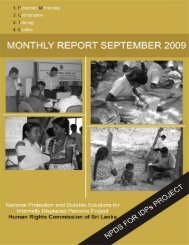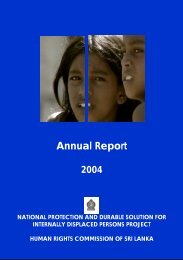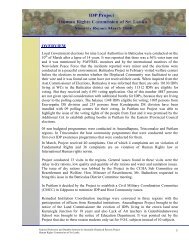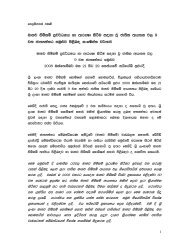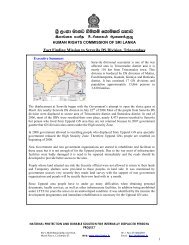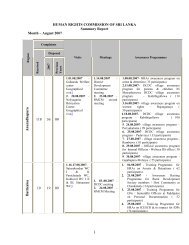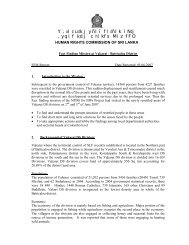Right to Health of Internally Displaced Persons - IDP SriLanka
Right to Health of Internally Displaced Persons - IDP SriLanka
Right to Health of Internally Displaced Persons - IDP SriLanka
You also want an ePaper? Increase the reach of your titles
YUMPU automatically turns print PDFs into web optimized ePapers that Google loves.
7.6. Risk <strong>of</strong> HIV infections<br />
Sri Lanka is considered as having low prevalence <strong>of</strong> HIV notably less<br />
85<br />
than 0.1 percent (3800 persons) . The Government <strong>of</strong> Sri Lanka initiated<br />
HIV prevention and control efforts through the National STD and AIDS<br />
Control Program (NSACP) <strong>of</strong> the Ministry <strong>of</strong> <strong>Health</strong> in 1992.<strong>IDP</strong><br />
community can be considered as most-at-risk population (MARP) <strong>to</strong><br />
HIV and among the displaced community, especially women and<br />
children are vulnerable <strong>to</strong> sexual abuses and such incidents are not<br />
revealed <strong>to</strong> the world easily and most <strong>of</strong>ten remain as hidden crimes.<br />
86<br />
At present there are about 81,000 Sri Lankan refugees living in India ,<br />
and the only humanitarian package, available <strong>to</strong> them is the dry ration.<br />
Due <strong>to</strong> their poverty, they are being forced <strong>to</strong> engage in prostitution.<br />
During the study it was observed that those Indian refugees are coming<br />
back in<strong>to</strong> Sri Lanka through illegal ways. The problem posed here is that<br />
the unavailability <strong>of</strong> a mechanism <strong>to</strong> test them whether they are infected<br />
with HIV or not. However such kind <strong>of</strong> unavailability is understandable<br />
since the migration is done by illegal ways. But re-integration <strong>of</strong> them<br />
in<strong>to</strong> the community will pose serious health risks because they<br />
themselves may not be aware <strong>of</strong> the infection and this fact urges a<br />
mechanism <strong>to</strong> check the infectious status at the grass root level.<br />
7.7. Mental health <strong>of</strong> <strong>IDP</strong>s<br />
Inheriting a civil conflict for more than 25 years the fac<strong>to</strong>rs like loss <strong>of</strong><br />
loved ones, families, wealth and livelihood have caused majority <strong>of</strong> the<br />
people in war affected area <strong>to</strong> be mentally disordered. The security<br />
concerns and frequent threats <strong>to</strong> the life have also amplified the number<br />
<strong>of</strong> mentally affected patients. In Puttalam, it was reported that out <strong>of</strong> 300<br />
87<br />
patients coming for the psychiatric clinics, majority are <strong>IDP</strong>s .<br />
85<br />
http://web.worldbank.org/WBSITE/EXTERNAL/COUNTRIES/SOUTHASIAEXT/<br />
EXTSAREGTOPHEANUT/EXTSAREGTOPHIVAIDS/0,,contentMDK:20287586~<br />
menuPK:568884~pagePK:34004173~piPK:34003707~theSitePK:496967,00.html<br />
86<br />
87<br />
http://www.refugeesinternational.org/content/article/detail/933/, as at 20.01.2004<br />
Observed from the discussion with Dr. Fareed District Medical Officer<br />
61






